QUT NSB010: Clinical Judgement and Decision-Making Nursing Case Study
VerifiedAdded on 2023/01/07
|5
|1012
|78
Case Study
AI Summary
This case study analyzes a 72-year-old patient, Suzanne Vorster, residing at an aged care facility, presenting with breathing difficulties. The assignment explores the patient's medical history of COPD and Alzheimer's disease. It requires the identification and justification of two nursing assessments, factors contributing to dyspnea, and the priority goal for care. Furthermore, it necessitates the identification and justification of two nurse-initiated, evidence-based interventions. The SBAR framework is applied to analyze the patient's situation, providing a structured approach to communication and care planning. The solution emphasizes the importance of patient and family teaching, direct or controlled coughing, immediate-release oral interventions, and person-centered care to improve patient outcomes and quality of life. The references include relevant books and journals supporting the evidence-based interventions and clinical judgment.
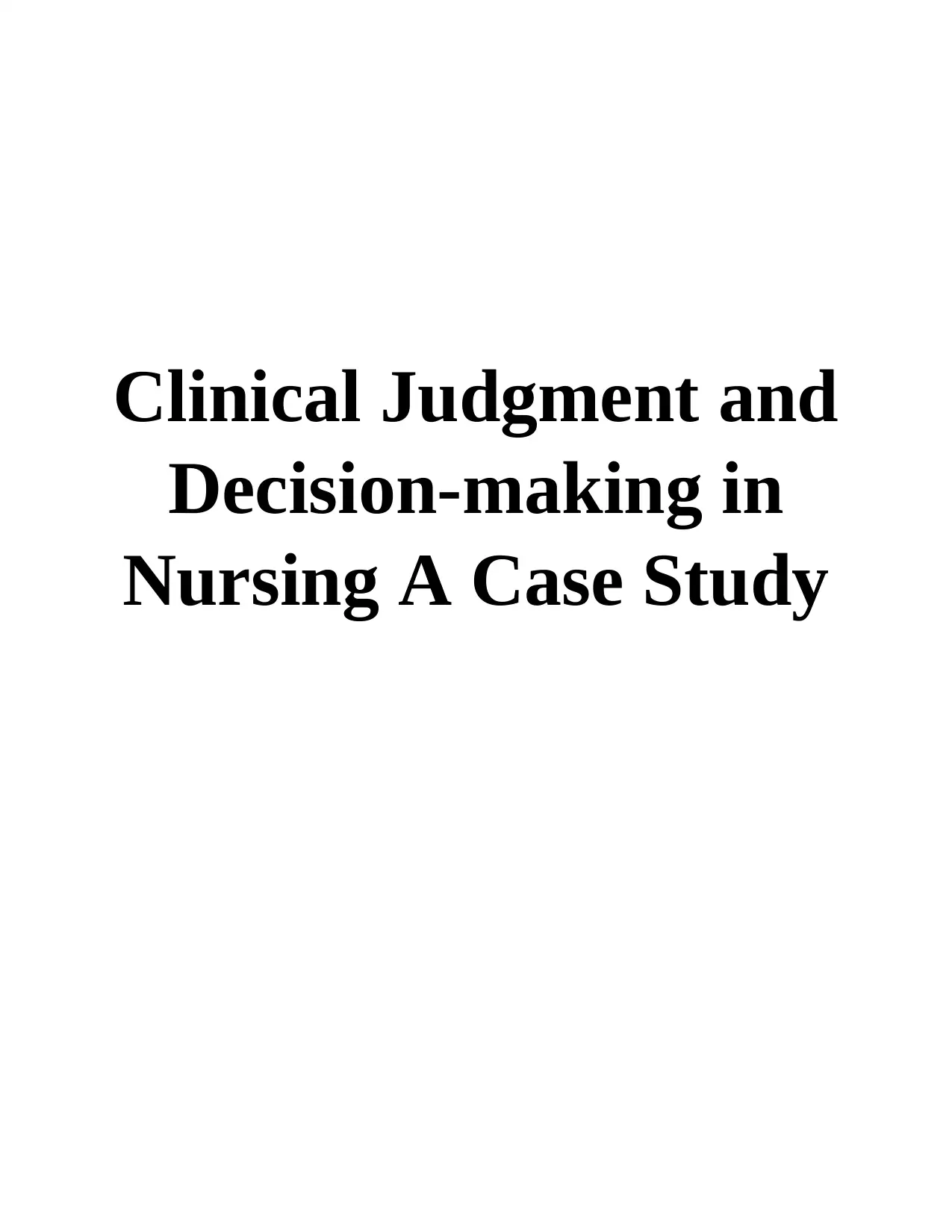
Clinical Judgment and
Decision-making in
Nursing A Case Study
Decision-making in
Nursing A Case Study
Paraphrase This Document
Need a fresh take? Get an instant paraphrase of this document with our AI Paraphraser
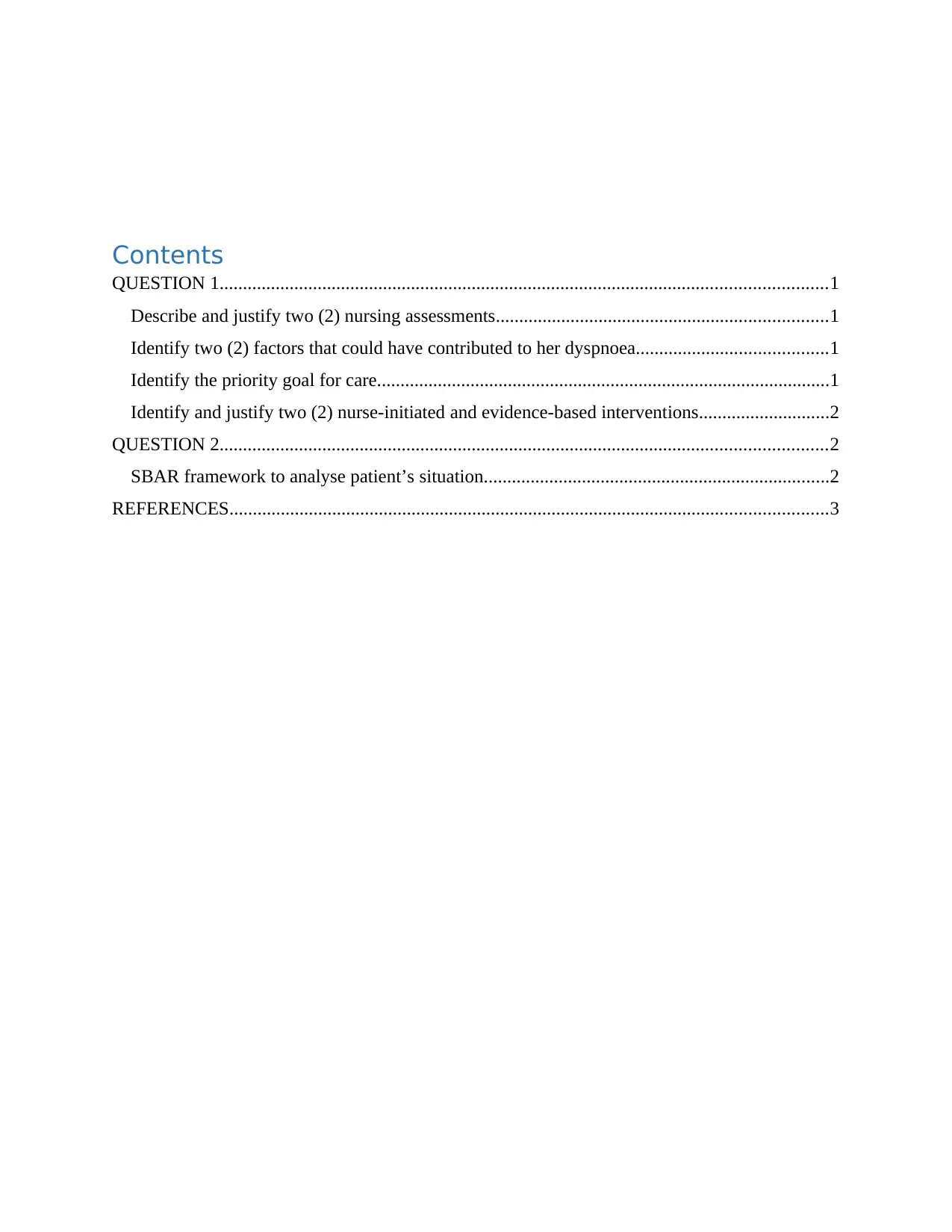
Contents
QUESTION 1..................................................................................................................................1
Describe and justify two (2) nursing assessments.......................................................................1
Identify two (2) factors that could have contributed to her dyspnoea.........................................1
Identify the priority goal for care.................................................................................................1
Identify and justify two (2) nurse-initiated and evidence-based interventions............................2
QUESTION 2..................................................................................................................................2
SBAR framework to analyse patient’s situation..........................................................................2
REFERENCES................................................................................................................................3
QUESTION 1..................................................................................................................................1
Describe and justify two (2) nursing assessments.......................................................................1
Identify two (2) factors that could have contributed to her dyspnoea.........................................1
Identify the priority goal for care.................................................................................................1
Identify and justify two (2) nurse-initiated and evidence-based interventions............................2
QUESTION 2..................................................................................................................................2
SBAR framework to analyse patient’s situation..........................................................................2
REFERENCES................................................................................................................................3
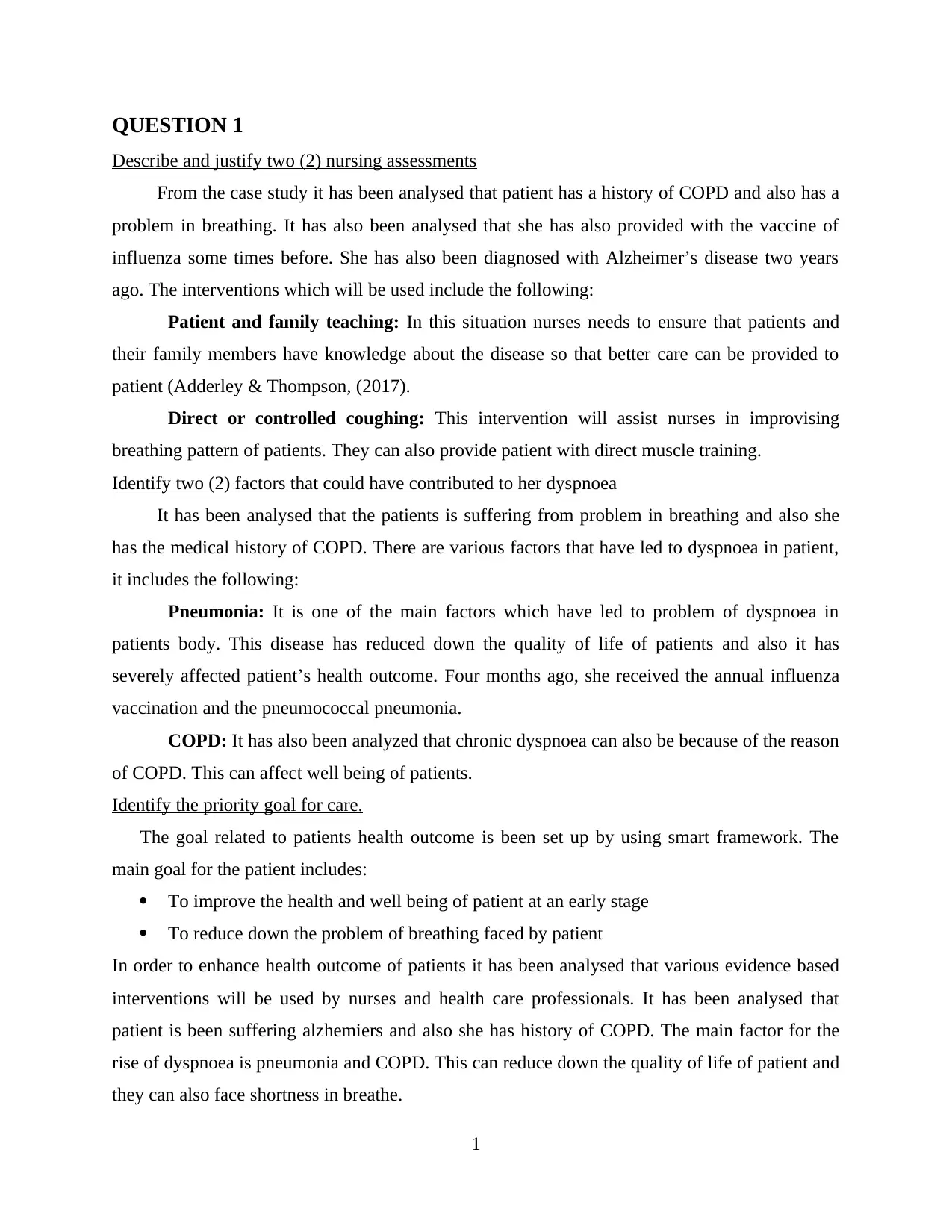
QUESTION 1
Describe and justify two (2) nursing assessments
From the case study it has been analysed that patient has a history of COPD and also has a
problem in breathing. It has also been analysed that she has also provided with the vaccine of
influenza some times before. She has also been diagnosed with Alzheimer’s disease two years
ago. The interventions which will be used include the following:
Patient and family teaching: In this situation nurses needs to ensure that patients and
their family members have knowledge about the disease so that better care can be provided to
patient (Adderley & Thompson, (2017).
Direct or controlled coughing: This intervention will assist nurses in improvising
breathing pattern of patients. They can also provide patient with direct muscle training.
Identify two (2) factors that could have contributed to her dyspnoea
It has been analysed that the patients is suffering from problem in breathing and also she
has the medical history of COPD. There are various factors that have led to dyspnoea in patient,
it includes the following:
Pneumonia: It is one of the main factors which have led to problem of dyspnoea in
patients body. This disease has reduced down the quality of life of patients and also it has
severely affected patient’s health outcome. Four months ago, she received the annual influenza
vaccination and the pneumococcal pneumonia.
COPD: It has also been analyzed that chronic dyspnoea can also be because of the reason
of COPD. This can affect well being of patients.
Identify the priority goal for care.
The goal related to patients health outcome is been set up by using smart framework. The
main goal for the patient includes:
To improve the health and well being of patient at an early stage
To reduce down the problem of breathing faced by patient
In order to enhance health outcome of patients it has been analysed that various evidence based
interventions will be used by nurses and health care professionals. It has been analysed that
patient is been suffering alzhemiers and also she has history of COPD. The main factor for the
rise of dyspnoea is pneumonia and COPD. This can reduce down the quality of life of patient and
they can also face shortness in breathe.
1
Describe and justify two (2) nursing assessments
From the case study it has been analysed that patient has a history of COPD and also has a
problem in breathing. It has also been analysed that she has also provided with the vaccine of
influenza some times before. She has also been diagnosed with Alzheimer’s disease two years
ago. The interventions which will be used include the following:
Patient and family teaching: In this situation nurses needs to ensure that patients and
their family members have knowledge about the disease so that better care can be provided to
patient (Adderley & Thompson, (2017).
Direct or controlled coughing: This intervention will assist nurses in improvising
breathing pattern of patients. They can also provide patient with direct muscle training.
Identify two (2) factors that could have contributed to her dyspnoea
It has been analysed that the patients is suffering from problem in breathing and also she
has the medical history of COPD. There are various factors that have led to dyspnoea in patient,
it includes the following:
Pneumonia: It is one of the main factors which have led to problem of dyspnoea in
patients body. This disease has reduced down the quality of life of patients and also it has
severely affected patient’s health outcome. Four months ago, she received the annual influenza
vaccination and the pneumococcal pneumonia.
COPD: It has also been analyzed that chronic dyspnoea can also be because of the reason
of COPD. This can affect well being of patients.
Identify the priority goal for care.
The goal related to patients health outcome is been set up by using smart framework. The
main goal for the patient includes:
To improve the health and well being of patient at an early stage
To reduce down the problem of breathing faced by patient
In order to enhance health outcome of patients it has been analysed that various evidence based
interventions will be used by nurses and health care professionals. It has been analysed that
patient is been suffering alzhemiers and also she has history of COPD. The main factor for the
rise of dyspnoea is pneumonia and COPD. This can reduce down the quality of life of patient and
they can also face shortness in breathe.
1
⊘ This is a preview!⊘
Do you want full access?
Subscribe today to unlock all pages.

Trusted by 1+ million students worldwide
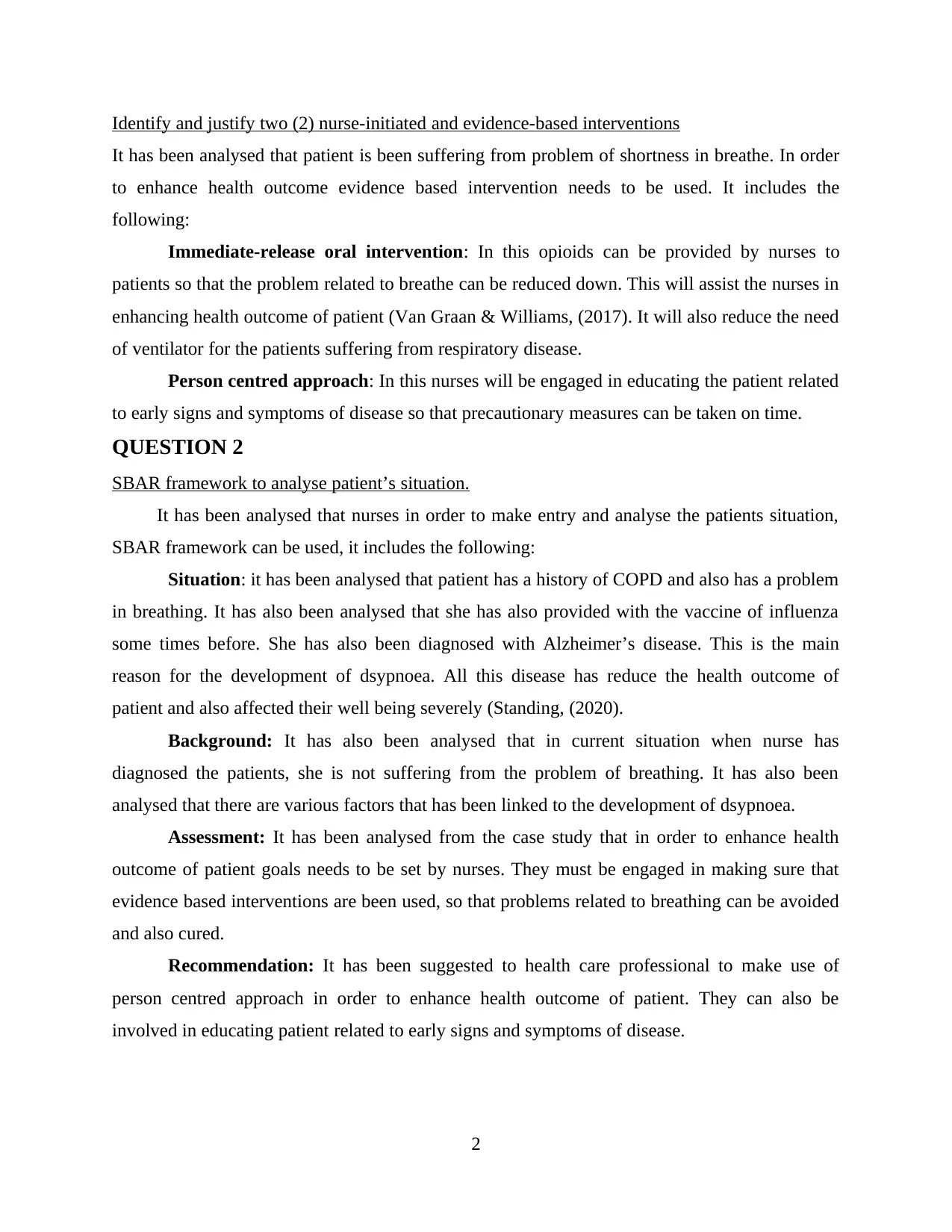
Identify and justify two (2) nurse-initiated and evidence-based interventions
It has been analysed that patient is been suffering from problem of shortness in breathe. In order
to enhance health outcome evidence based intervention needs to be used. It includes the
following:
Immediate-release oral intervention: In this opioids can be provided by nurses to
patients so that the problem related to breathe can be reduced down. This will assist the nurses in
enhancing health outcome of patient (Van Graan & Williams, (2017). It will also reduce the need
of ventilator for the patients suffering from respiratory disease.
Person centred approach: In this nurses will be engaged in educating the patient related
to early signs and symptoms of disease so that precautionary measures can be taken on time.
QUESTION 2
SBAR framework to analyse patient’s situation.
It has been analysed that nurses in order to make entry and analyse the patients situation,
SBAR framework can be used, it includes the following:
Situation: it has been analysed that patient has a history of COPD and also has a problem
in breathing. It has also been analysed that she has also provided with the vaccine of influenza
some times before. She has also been diagnosed with Alzheimer’s disease. This is the main
reason for the development of dsypnoea. All this disease has reduce the health outcome of
patient and also affected their well being severely (Standing, (2020).
Background: It has also been analysed that in current situation when nurse has
diagnosed the patients, she is not suffering from the problem of breathing. It has also been
analysed that there are various factors that has been linked to the development of dsypnoea.
Assessment: It has been analysed from the case study that in order to enhance health
outcome of patient goals needs to be set by nurses. They must be engaged in making sure that
evidence based interventions are been used, so that problems related to breathing can be avoided
and also cured.
Recommendation: It has been suggested to health care professional to make use of
person centred approach in order to enhance health outcome of patient. They can also be
involved in educating patient related to early signs and symptoms of disease.
2
It has been analysed that patient is been suffering from problem of shortness in breathe. In order
to enhance health outcome evidence based intervention needs to be used. It includes the
following:
Immediate-release oral intervention: In this opioids can be provided by nurses to
patients so that the problem related to breathe can be reduced down. This will assist the nurses in
enhancing health outcome of patient (Van Graan & Williams, (2017). It will also reduce the need
of ventilator for the patients suffering from respiratory disease.
Person centred approach: In this nurses will be engaged in educating the patient related
to early signs and symptoms of disease so that precautionary measures can be taken on time.
QUESTION 2
SBAR framework to analyse patient’s situation.
It has been analysed that nurses in order to make entry and analyse the patients situation,
SBAR framework can be used, it includes the following:
Situation: it has been analysed that patient has a history of COPD and also has a problem
in breathing. It has also been analysed that she has also provided with the vaccine of influenza
some times before. She has also been diagnosed with Alzheimer’s disease. This is the main
reason for the development of dsypnoea. All this disease has reduce the health outcome of
patient and also affected their well being severely (Standing, (2020).
Background: It has also been analysed that in current situation when nurse has
diagnosed the patients, she is not suffering from the problem of breathing. It has also been
analysed that there are various factors that has been linked to the development of dsypnoea.
Assessment: It has been analysed from the case study that in order to enhance health
outcome of patient goals needs to be set by nurses. They must be engaged in making sure that
evidence based interventions are been used, so that problems related to breathing can be avoided
and also cured.
Recommendation: It has been suggested to health care professional to make use of
person centred approach in order to enhance health outcome of patient. They can also be
involved in educating patient related to early signs and symptoms of disease.
2
Paraphrase This Document
Need a fresh take? Get an instant paraphrase of this document with our AI Paraphraser
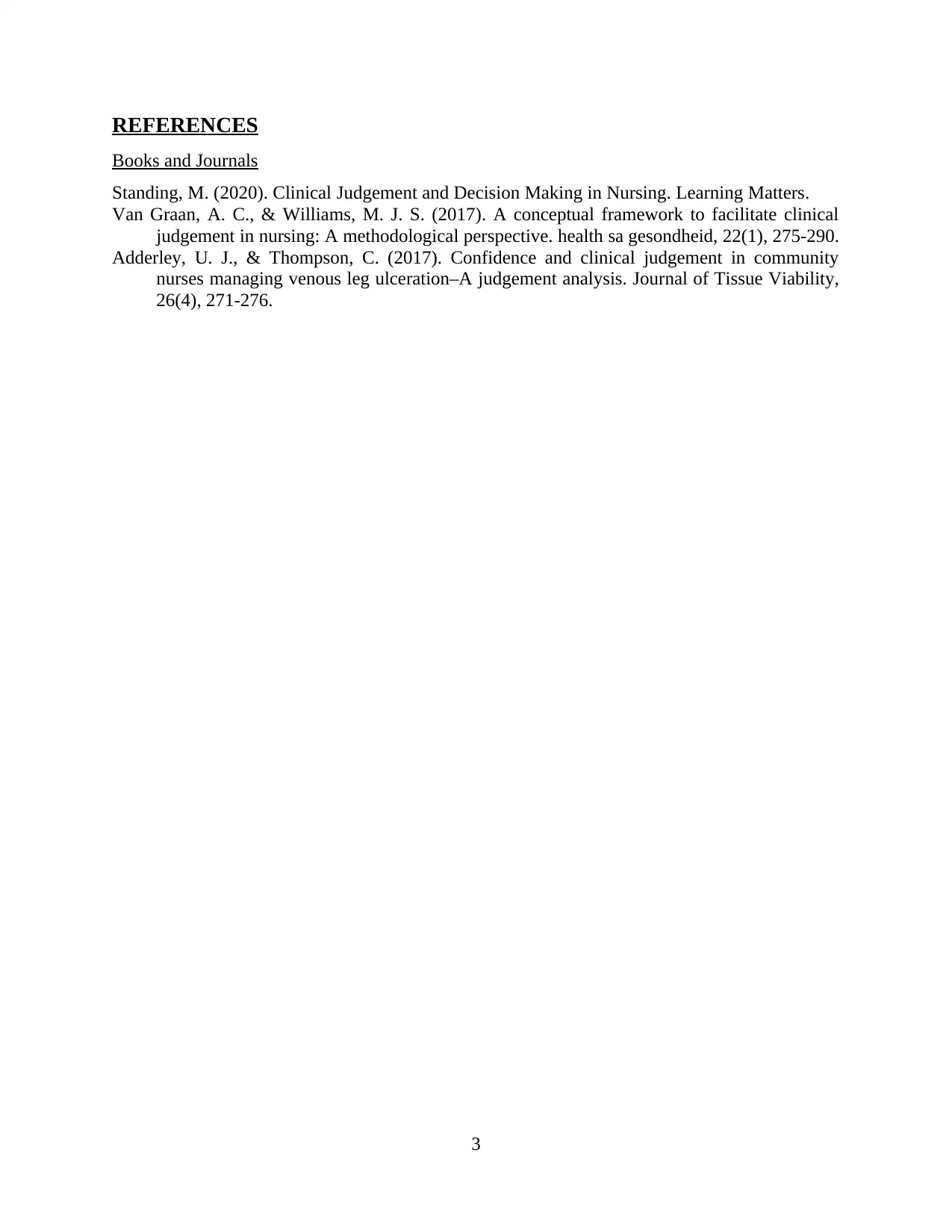
REFERENCES
Books and Journals
Standing, M. (2020). Clinical Judgement and Decision Making in Nursing. Learning Matters.
Van Graan, A. C., & Williams, M. J. S. (2017). A conceptual framework to facilitate clinical
judgement in nursing: A methodological perspective. health sa gesondheid, 22(1), 275-290.
Adderley, U. J., & Thompson, C. (2017). Confidence and clinical judgement in community
nurses managing venous leg ulceration–A judgement analysis. Journal of Tissue Viability,
26(4), 271-276.
3
Books and Journals
Standing, M. (2020). Clinical Judgement and Decision Making in Nursing. Learning Matters.
Van Graan, A. C., & Williams, M. J. S. (2017). A conceptual framework to facilitate clinical
judgement in nursing: A methodological perspective. health sa gesondheid, 22(1), 275-290.
Adderley, U. J., & Thompson, C. (2017). Confidence and clinical judgement in community
nurses managing venous leg ulceration–A judgement analysis. Journal of Tissue Viability,
26(4), 271-276.
3
1 out of 5
Related Documents
Your All-in-One AI-Powered Toolkit for Academic Success.
+13062052269
info@desklib.com
Available 24*7 on WhatsApp / Email
![[object Object]](/_next/static/media/star-bottom.7253800d.svg)
Unlock your academic potential
Copyright © 2020–2025 A2Z Services. All Rights Reserved. Developed and managed by ZUCOL.




